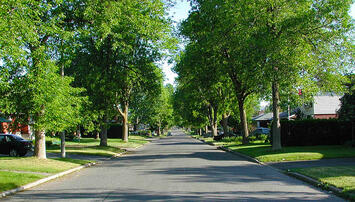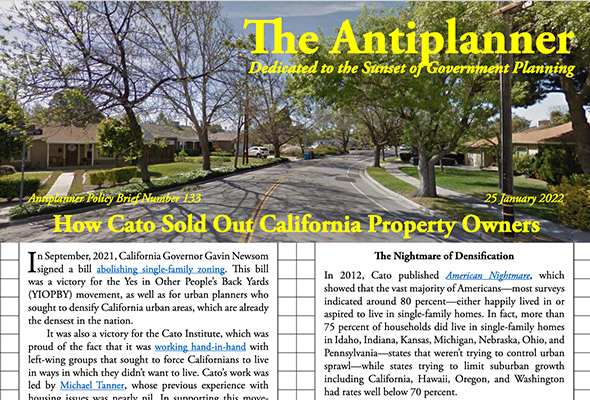
In September, 2021, California Governor Gavin Newsom signed a bill abolishing single-family zoning. This bill was a victory for the Yes in Other People’s Back Yards (YIOPBY) movement, as well as for urban planners who sought to densify California urban areas, which are already the densest in the nation.
It was also a victory for the Cato Institute, which was proud of the fact that it was working hand-in-hand with left-wing groups that sought to force Californians to live in ways in which they didn’t want to live. Cato’s work was led by Michael Tanner, whose previous experience with housing issues was nearly nil. In supporting this movement, Cato and Tanner ignored everything I had written in two books and seven policy papers for Cato over the previous fourteen years.
Click here to download the report (link opens in new tab or window).
Cato hired me in 2007 explicitly to work on urban land-use and transportation issues. When it did so, it noted that my previous “work showed that urban planning was not making cities more livable, but instead was increasing congestion and making housing less affordable.”
During my first year, Cato published my 416-page book, The Best-Laid Plans, which showed that urban planners had an irrational mania for density that was making housing less affordable in regions that attempted to stop the growth of low-density suburbs. In the same year, Cato published a paper that I wrote showing that San Jose’s urban-growth boundary was rapidly densifying that city to the detriment of congestion and affordability, along with two other papers on housing issues.
In 2009, Cato published The Myth of the Compact City, a paper I wrote showing that all the arguments for densification were faulty. We didn’t need to force people to live in high densities to save farms, forests, and open space because all the urban areas of the country occupied just 3 percent of the nation’s land area. Nor would density reduce air pollution or greenhouse gas emissions: people living in dense areas actually use more energy for transportation than those in low densities because they drive in more congested conditions, while multifamily housing uses more energy per square foot than single-family homes.
The Nightmare of Densification
In 2012, Cato published American Nightmare, which showed that the vast majority of Americans—most surveys indicated around 80 percent—either happily lived in or aspired to live in single-family homes. In fact, more than 75 percent of households did live in single-family homes in Idaho, Indiana, Kansas, Michigan, Nebraska, Ohio, and Pennsylvania–states that weren’t trying to control urban sprawl–while states trying to limit suburban growth including California, Hawaii, Oregon, and Washington had rates well below 70 percent.
American Nightmare also showed that the desire for single-family housing went back at least into the nineteenth century, but transportation had been the main barrier to that dream. Early cities were dense because the main form of transportation was on foot, so people who didn’t want to walk long distances to work often lived in multifamily housing. The development of steam-powered commuter trains in the 1830s, electric streetcars in the 1880s, and affordable mass-produced automobiles in the 1910s allowed successively lower-income people to live in single-family homes.
American Nightmare further showed that the desire for single-family housing was strongly associated with the desire for homeownership. Census data show that nearly 83 percent of occupied single-family homes are occupied by their owners, while nearly 87 percent of multifamily dwellings are occupied by renters.
Read the rest of this piece at The Antiplanner.
Randal O’Toole, the Antiplanner, is a policy analyst with nearly 50 years of experience reviewing transportation and land-use plans and the author of The Best-Laid Plans: How Government Planning Harms Your Quality of Life, Your Pocketbook, and Your Future.
Photo: F Grammen, via Wikimediaunder CC 0 1.0 Public Domain.













